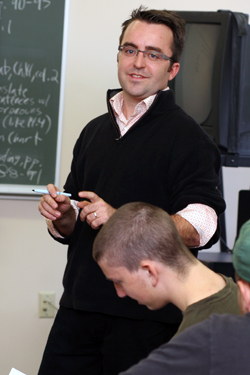A school year that started off with fly fishing as a liberal art takes a more classical turn this week with a liberal arts focus on Pompeii, Italy.
Assistant Professor of Classics Jeremy Hartnett ’96 will welcome eight colleagues from across the nation to “Teaching Pompeii in a Liberal Arts Setting: Contexts, Interdisciplinarity, and Collaboration.”

“You could go around the campus and think about the material produced at Pompeii and how it touches on the different realms of life.” Hartnett said. “The liberal arts and Pompeii go together from the disciplinary approach to the site and also the material generated from the site.
“I wanted to organize this workshop as a way to explore that richness and also to see how my colleagues are teaching. I’m the only Roman archeologist on this campus and that’s true of all my colleagues invited to this workshop. Yet, this is a fundamental part of most of our curricula and we don’t get to talk about it very much. There aren’t many conversations happening on how to teach Pompeii or archeology.”
The conference kicks off with a keynote address from Wesleyan University’s Christopher Parslow. His lecture is titled, “Archeology in the Praedia (Properties) of Julia Felix in Pompeii.” Parslow will speak at 4:30 p.m., Thursday, in Baxter 101.
The eight visiting scholars will arrive Thursday afternoon and take part in sessions through Saturday afternoon.
Students in Hartnett’s Art/Classics 104: Roman Art and Archeology will be participating. He has led the Wabash men through a module about Pompeii and expects the students to be active participants during portions of the workshop.
Archeology and the liberal arts are natural partners, Hartnett explained. “Pompeii can be studied by a classics professor who can bring his or her perspective to it. It can also be studied fruitfully by a scientist.”
He went on to add students in his class have been reading about the study of bones from those found in the ruins. Other students have been reading analysis on the deposits on the inside walls of the aqueduct, studying about the cavities left by root systems and another group looked at the eruption itself .
"The sciences can look at Pompeii and have a whole different set of questions and skills they bring to the site, Hartnett said. "You could go around the campus and think about how the material produced at Pompeii and how it touches on the different realms of life; so the liberal arts and Pompeii go together.”
Hartnett also wanted to organize the workshop to help all nine participants bring a liberal arts perspective, not just to their teaching, but their respective campuses. “There is basically no scholarship done on how to teach archeology,” he said. “It’s a shame because cities like Pompeii offer us a remarkable laboratory for thinking about the human experience (or the liberal arts).”
The workshop will include presentations of scholarly work and discussion on research and teaching.
“Most of these people come from liberal arts colleges and dedicate their lives to teaching the Classics and classical archeology,” Hartnett said. “But at same time these people all have very active research programs. One of the specific challenges or working at Pompeii is how to get your research into the classroom or have students contribute to your research. So that’s another question this conference will explore.”
The workshop is funded by the Center of Inquiry in the Liberal Arts.
 “You could go around the campus and think about the material produced at Pompeii and how it touches on the different realms of life.” Hartnett said. “The liberal arts and Pompeii go together from the disciplinary approach to the site and also the material generated from the site.
“You could go around the campus and think about the material produced at Pompeii and how it touches on the different realms of life.” Hartnett said. “The liberal arts and Pompeii go together from the disciplinary approach to the site and also the material generated from the site.